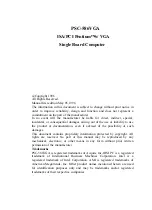
322
Document # 001-20559 Rev. *D
Section G: Glossary
AND
.
API (Application Pro-
gramming Interface)
A series of software routines that comprise an interface between a computer application and
lower-level services and functions (for example, user modules and libraries). APIs serve as
building blocks for programmers that create software applications.
array
An array, also known as a vector or list, is one of the simplest data structures in computer pro-
gramming. Arrays hold a fixed number of equally-sized data elements, generally of the same
data type. Individual elements are accessed by index using a consecutive range of integers, as
opposed to an associative array. Most high level programming languages have arrays as a built-
in data type. Some arrays are multi-dimensional, meaning they are indexed by a fixed number of
integers; for example, by a group of two integers. One- and two-dimensional arrays are the most
common. Also, an array can be a group of capacitors or resistors connected in some common
form.
assembly
A symbolic representation of the machine language of a specific processor. Assembly language
is converted to machine code by an assembler. Usually, each line of assembly code produces
one machine instruction, though the use of macros is common. Assembly languages are consid-
ered low level languages; where as C is considered a high level language.
asynchronous
A signal whose data is acknowledged or acted upon immediately, irrespective of any clock sig-
nal.
attenuation
The decrease in intensity of a signal as a result of absorption of energy and of scattering out of
the path to the detector, but not including the reduction due to geometric spreading. Attenuation
is usually expressed in dB.
B
bandgap reference
A stable voltage reference design that matches the positive temperature coefficient of V
T
with
the negative temperature coefficient of V
BE
, to produce a zero temperature coefficient (ideally)
reference.
bandwidth
1. The frequency range of a message or information processing system measured in hertz.
2. The width of the spectral region over which an amplifier (or absorber) has substantial gain (or
loss); it is sometimes represented more specifically as, for example, full width at half maxi-
mum.
bias
1. A systematic deviation of a value from a reference value.
2. The amount by which the average of a set of values departs from a reference value.
3. The electrical, mechanical, magnetic, or other force (field) applied to a device to establish a
reference level to operate the device.
bias current
The constant low level DC current that is used to produce a stable operation in amplifiers. This
current can sometimes be changed to alter the bandwidth of an amplifier.
binary
The name for the base 2 numbering system. The most common numbering system is the base
10 numbering system. The base of a numbering system indicates the number of values that may
exist for a particular positioning within a number for that system. For example, in base 2, binary,
each position may have one of two values (0 or 1). In the base 10, decimal, numbering system,
each position may have one of ten values (0, 1, 2, 3, 4, 5, 6, 7, 8, and 9).
Summary of Contents for PSoC CY8C23533
Page 4: ...Contents Overview 4 Document 001 20559 Rev D Section G Glossary 385 Index 401 ...
Page 16: ...Contents Overview 16 Document 001 20559 Rev D ...
Page 24: ...24 Document 001 20559 Rev D Section A Overview ...
Page 30: ...30 Document 001 20559 Rev D Pin Information ...
Page 54: ...54 Document 001 20559 Rev D Supervisory ROM SROM ...
Page 60: ...60 Document 001 20559 Rev D RAM Paging ...
Page 68: ...68 Document 001 20559 Rev D Interrupt Controller ...
Page 76: ...12 Document 001 20559 Rev D General Purpose IO GPIO ...
Page 82: ...18 Document 001 20559 Rev D Internal Main Oscillator IMO ...
Page 84: ...20 Document 001 20559 Rev D Internal Low Speed Oscillator ILO ...
Page 90: ...26 Document 001 20559 Rev D External Crystal Oscillator ECO ...
Page 94: ...30 Document 001 20559 Rev D Phase Locked Loop PLL ...
Page 106: ...42 Document 001 20559 Rev D Sleep and Watchdog ...
Page 228: ...164 Document 001 20559 Rev D Section D Digital System ...
Page 234: ...170 Document 001 20559 Rev D Array Digital Interconnect ADI ...
Page 278: ...214 Document 001 20559 Rev D Digital Blocks ...
Page 296: ...232 Document 001 20559 Rev D Analog Interface ...
Page 304: ...240 Document 001 20559 Rev D Analog Array ...
Page 308: ...244 Document 001 20559 Rev D Analog Input Configuration ...
Page 312: ...248 Document 001 20559 Rev D Analog Reference ...
Page 338: ...274 Document 001 20559 Rev D Section F System Resources ...
Page 354: ...290 Document 001 20559 Rev D Multiply Accumulate MAC ...
Page 374: ...310 Document 001 20559 Rev D I2C ...
Page 400: ...336 Document 001 20559 Rev D Section G Glossary ...


































